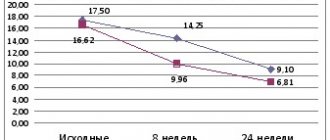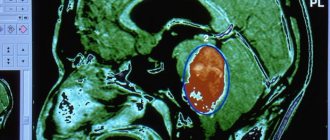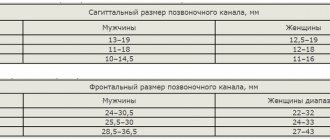A nervous tic of the eye is a rapid and involuntary contraction of small muscles around the eye, characterized by their uniformity. This condition is scientifically called blepharospasm.
Some people experience this condition once, while others suffer for years. Today, this problem is very relevant, because life is intense now and people are in constant tension and stress. Nervous eye tics are more common in children than in adults. It usually goes away on its own, without the use of medications. But it happens that blepharospasm appears again and again, thereby interfering with a person’s normal life. Then treatment cannot be avoided and the person is sent to a neurologist.
Primary tic
Primary tics can appear periodically even in a healthy person. This type of tic occurs as a result of the reaction of nerve endings to a stimulus. Such an irritant can be a stressful situation, a feeling of fear or emotional overstrain. This phenomenon most often goes away on its own, without specific treatment. Due to emotional instability, it is mainly children who are susceptible to nervous tics. In adults, a similar symptom also occurs against the background of a sharp change in emotional state. If a nervous tic appears in this case, you should look for the cause in the health of the nervous system.
Symptoms of blepharospasm in adults
The main manifestation of an eye tic is a sharp, uncontrolled contraction of the external eye muscle.
The levels of spasm can be different : a barely noticeable twitching of the eyelids or a complete closure of the eye. The amplitude is individual, depending on the severity of the eye tic.
Symptoms in adults occur after severe emotional stress , and stop when the person calms down. Blepharospasm, morally and psychologically, creates inconvenience and unpleasant, painful sensations in a person. This comes from suppressing spasms through willpower.
In a state of sleep, a nervous tic does not occur. Often during illness a person withdraws into himself. This factor aggravates neuroticism and symptoms of blepharospasm.
Tourette's syndrome
In addition, there are a number of hereditary pathologies that can be accompanied by nervous tics. One such disease is Tourette's syndrome. It is diagnosed in childhood. The main symptom of the syndrome is uncontrolled, spontaneous tics of the vocal and motor type.
Tics are localized in different parts of the body, and contraction of the abdominal muscles is quite common. The presence of Tourette syndrome in a child indicates the presence of this pathology in close relatives. The intensity of symptoms can vary and smooth out with age.
The treatment of a nervous tic largely depends on the factor that led to its occurrence.
Causes
A nervous tic of the eye in an adult can develop for the following reasons:
- Lack of sleep, insomnia.
- Physical or emotional overstrain.
- Past serious illnesses caused by infection.
- Lack of sleep and rest, high rhythm of life.
- Micronutrient deficiency.
- Infectious eye lesions.
The causes of nervous eye tics should be determined by a doctor.
Pathology is a consequence of a malfunction that occurred in the body against the background of a stressful situation. The body can also react in the form of eye twitching to a lack of microelements, especially magnesium and calcium, which determine the normal functioning of the human central nervous system.
Ophthalmological diseases that arise against the background of an inflammatory process can also cause involuntary contractions of the facial muscles. With blepharitis or conjunctivitis, in the absence of timely treatment, inflammation can, under certain conditions, spread to the nerve endings of the eyes, which will cause their involuntary twitching.
Causes of eye tics: what causes the disease
The main cause of the disease is considered to be disturbances in the processes of the nervous system. Namely, the regulation on which the contractile system of the eye muscles depends.
However, ocular function and vision are normal.
In addition, possible factors that influence the onset of the disease are:
- Emotional state disorders (neurosis, severe overstrain, constant mental stress). It is this reason that most often causes the appearance of a nervous tic. In other words, any severe stress can lead to blepharospasm.
- Various diseases of the brain: sclerosis at different stages, tumor, impaired blood flow, vegetative-vascular dystonia. There are cases when a nervous tic occurs as a result of a traumatic brain injury or after treatment for a brain infection.
- Insufficient amounts of microelements (magnesium and calcium). This is why the whole body suffers greatly, feeling a constant loss of strength and emotional exhaustion.
- Genetic factor. It is the predisposition to such a disease that can begin to manifest itself at an early age.
- Long-term use of psychostimulants.
- Severe fatigue.
- Very rarely, blepharospasm can be caused by the presence of helminthic infestation.
Reference! Sometimes the reasons are bad habits . Smoking, alcohol and drinking large amounts of coffee cause stress, which leads to the appearance of a nervous tic.
Symptoms
If the cause of the development of a nervous tic is a disease of the human nervous system, then, in addition to muscle contraction, the following symptoms are revealed:
- Convulsive syndrome.
- Increased irritability.
- Decreased muscle tone.
Involuntary contractions of the facial muscles can develop after suffering a serious illness. In this case, the tic is a kind of reaction of the nervous system to severe exhaustion of the body and a decrease in its protective properties.
The causes and treatment of nervous tics of the eye are interrelated.
Only by diagnosing the exact cause of a pathology such as a nervous tic can it be possible to determine further actions and the necessary therapy. The diagnosis must be made by a specialist, since improper treatment, at best, will leave everything as it is, and at worst, it can lead to complications and deterioration of the patient’s condition.
Which doctor should I go to?
Involuntary muscle contractions appear due to neurological pathologies, so you should consult a neurologist for an initial consultation. The specialist will examine and collect the patient’s medical history, and also prescribe a brain examination using magnetic resonance imaging. This type of study will exclude organic diseases of the nervous system.
A nervous tic may be a consequence of mental disorders, so the patient is advised to visit a psychiatrist without fail. It is also necessary to exclude the presence of malignant neoplasms. Having received the results of all the necessary studies, the specialist prescribes drug therapy to eliminate the cause of the disease and relieve symptoms.
Having identified the nature of the nervous tic, the specialist selects treatment taking into account the individual characteristics of the patient and the nature of the disease. If a disorder of the nervous system is associated with previous ophthalmological pathologies, you should also consult an ophthalmologist.
Treatment of nervous eye tics
Having determined the factor that provokes contraction of the facial muscles, the specialist selects a treatment regimen. Quite often it is enough to eliminate nervous exhaustion and a stressful stimulus to get rid of a nervous tic. Sometimes a nervous tic goes away when a person adjusts his sleep and rest patterns or reduces the amount of workload. After some time, the intensity of the tic decreases, it becomes more rare and less pronounced. To get rid of the residual effect, it will be enough to attend several sessions of psychotherapy and establish a regimen.
Treatment of nervous eye tics in adults with medications involves taking sedatives and muscle relaxants. Various medications with a sedative effect help eliminate insomnia and normalize sleep. If the tic problem is severe, sedatives alone will not be enough, so a specialist may also prescribe tranquilizers and antidepressants, which will help reduce nervous tension and anxiety.
Muscle relaxants make it possible to eliminate increased muscle tone, which leads to involuntary contractions. These drugs do not always show high effectiveness, so the advisability of taking them should be discussed with your doctor.
In exceptional cases, therapy may include antipsychotic drugs that help normalize metabolic processes in the human brain. The main negative feature of these drugs is the high probability of the body becoming accustomed to the active component. In this regard, antipsychotics are prescribed with increased caution.
In any case, treatment of nervous tics requires an integrated approach and a combination of different groups of drugs. It should also be borne in mind that a nervous tic is a recurrent disease and can return at any time.
How to treat a nervous tic and what to do if it does not go away?
Our body is an amazing, well-coordinated system. When this system fails, it immediately affects our health. Internal problems, one way or another, sooner or later begin to creep out.
Today we’ll talk about a disease of the nervous system – nervous tics. What kind of disease is this, where does it come from, what are its causes and how to cope with it?
What is a nervous tic?
A nervous tic is a rapid, repetitive, irregular movement caused by the contraction of certain muscles. Most often, the muscles of the face and arms contract, but absolutely any muscle group can be involved. A nervous tic occurs against a person’s will, can imitate a fragment of normal purposeful movements, but in itself is an absolutely useless action.
Sometimes, with an effort of will, you can suppress the occurrence of a tic, but not for long. Tics appear only during wakefulness. They do not have any pattern, they are always fast, abrupt, with different repetition intervals. Nervous tics are pathological conditions, but they do not always require treatment.
Almost every person in his life has “met” a nervous tic. In such cases they are called transient (temporary). For example, many people, during times of strong psycho-emotional stress, notice twitching of their eyelids. It is nervous tics of facial muscles and facial muscles that occur most often, including in healthy people.
Nervous tics are the result of increased activity of the so-called extrapyramidal system of the brain. This system is responsible for reproducing many of the automated movements of our body, that is, it works relatively independently without the participation of the cerebral cortex. When, for some reason, excitement circulates in the extrapyramidal system, this can be expressed in the appearance of nervous tics.
Symptoms and types of nervous tics
There is a general classification of neurological tics depending on their location, type of muscle contractions and other symptoms:
Vocal tics are uncontrolled contractions of the vocal cords, accompanied by changes in speech quality and voice timbre. These can be abrupt phrases, involuntary screams. In adults, they can manifest themselves in emotional shouting of words and even curses.
Limb tics are involuntary movements of the arms and legs. People with this pathology may nod or twist their heads, move their shoulders, twitch their arms, and straighten or clench their fingers.
Facial tics are cyclic contractions of the facial muscles, for example, nervous tics of the eye or eyelid, cheeks, eyebrows, lips... They manifest themselves in frequent blinking, wrinkling of the nose, movement of the eyebrows, rolling of the eyes, opening and closing of the eyelid.
The main symptoms of a nervous disorder in both adults and children are sudden, uncontrollable muscle contractions of varying intensity that cannot be suppressed. With each attempt to contain this phenomenon, the tension will increase, and the nervous tic will intensify.
So how to get rid of nervous tics? To cure a disease, you must first find out its cause.
Where are the roots of all diseases?
Our world is diverse and complex for some, but simple and great for others. The ability to behave, to subordinate thoughts to one’s will, to manage one’s condition in different situations, to launch the correct biochemical processes, allows a person to have strong energy and strong immunity, and therefore resistance to any diseases.
The integrity of the body begins to collapse with psycho-emotional factors that affect us every day. If a person knows how to cope with them, processing any emotional surges towards a positive shift forward for himself, he will be able to react easily to any uncomfortable situation, remain in good health and, moreover, develop his energy potential.
Otherwise, under the influence of a crazy pace of life, stressful situations at work, at home or on the road, a negative energy charge begins to accumulate, gradually destroying a person’s energy shell.
First, this affects a person’s psychological health; later, the destruction moves to the physical level, where internal organs begin to suffer and various sores appear.
Causes and factors contributing to the development of nervous tics
The main cause of nervous tics is an imbalance in the function of the nervous system. The brain sends “erroneous” nerve impulses to the muscles, which cause them to contract quickly and uniformly. This does not happen consciously, but as if by itself. A person cannot stop a tic of his own free will or prevent subsequent ones.
Depending on the cause of the nervous system imbalance, there are three types of nervous tics:
- primary
- secondary
- hereditary
Primary nervous tics develop against the background of a relatively normal state of the human central nervous system and are the only manifestation of a violation of its function. The appearance of a primary nervous tic may be preceded by stress, overwork, malnutrition, alcohol, and psychostimulant drugs.
People of the “Wind” constitution are predisposed to the occurrence of primary nervous tics. They are distinguished by their temper, emotionality, and pronounced manifestations of feelings. In such people, the central nervous system is especially sensitive to the influence of external factors, which contributes to the occurrence of nervous tics.
Secondary tics have a clear cause-and-effect relationship with an event or illness. It can be:
- traumatic brain injuries
- encephalitis
- cerebrovascular accidents
- taking a number of medications (neuroleptics, psychostimulants)
- drug use
- brain tumors
- a number of mental illnesses (schizophrenia and epilepsy)
- trigeminal neuralgia
- carbon monoxide poisoning
- vegetative-vascular dystonia
How to treat nervous tics using Tibetan medicine?
Rapid restoration of the body using Tibetan methods occurs thanks to methods of external and internal influence. Everything that can contribute to rapid recovery is taken into account. Lifestyle and nutrition also play an important role here.
From the point of view of Tibetan medicine, the harmony and health of our nervous system is ensured by the “Wind” constitution. Wind disturbance is first characterized by increased excitability, and later by a complete loss of strength. An imbalance of this constitution can be caused by uncontrollable aggressiveness, prolonged sadness, passion for possessing something, hypothermia and disordered eating with frequent consumption of “bitter” foods.
During the free pulse diagnostics, you are given an accurate diagnosis, your predominant constitution is determined, which is one of the most important points for setting up the correct treatment, the causes of the disease, concomitant diseases are determined, and based on these data, treatment is prescribed.
Doctors of Tibetan medicine consider nervous tics as a disease of “Cold”, so the treatment will necessarily include warming procedures and select the necessary diet. All treatment will occur through external and internal influences.
The main external influences include the following procedures:
- Acupuncture
- Moxibustion therapy
- Stone therapy
- Tibetan massage
- Vacuum therapy
- Hirudotherapy
- And others.
In combination with herbal medicine, these procedures provide a tremendous healing effect and allow you to quickly relieve pain and alleviate the condition.
Properly selected herbal remedies have an immunomodulatory, antibacterial and anti-inflammatory effect, harmonizing the state of the body’s internal systems.
An integrated approach is the basis of Tibetan medicine. External influence by the above procedures leads to the following:
- The functioning of the nervous system is restored
- Nervous tics go away
- Stagnation is eliminated
- Increases immunity
- Discomfort is relieved
- Concomitant diseases go away
- The general condition of the body improves
Tibetan medicine has helped many patients regain lost health. Even in those cases when ordinary doctors refused the patient, saying that he could no longer be helped, Tibetan medicine helped.
Not because she has some kind of magic pill, but because she has enormous knowledge about human nature and its interaction with this world. This experience has been accumulated over thousands of years and is now quickly gaining popularity due to its amazing results.
Without chemicals, antibiotics, painful procedures and surgeries, we manage to get people back on their feet, significantly improving their condition.
People also come to us to prevent diseases. Relax, unload your emotional state, raise your vitality and restore your energy.
After complex procedures, a person gains harmony with himself and the outside world for a long time. He simply glows with love, energy and life.
Therefore, if you have any health problems, come, we will help you.
Health to you and your loved ones!
Physiotherapy
There are special exercises for the facial muscles that make it possible to relax the tense area and thereby reduce the frequency of involuntary contractions. Gymnastics includes the following exercises:
1. Blink at a fast pace for a minute.
2. First, close your eyelids tightly, and then sharply protrude your eyes. Do several repetitions until tears appear. Once the tears flow, you need to stop.
3. The eyelids are not tightly closed until trembling appears in the eyes. Every effort must be made to stop the trembling without closing the eyelids completely.
4. At the final stage of gymnastics, you need to calmly close your eyelids and do a light massage with your fingertips. You should make circular movements without pressing hard on your eyelids.
Performing these exercises helps to gain control over the eye muscles, as well as relax tense areas of the face. Gymnastics allows you to relax every muscle, which has a beneficial effect on the state of the central nervous system.
How else to cure a nervous eye tic in an adult?
Traditional methods of treatment
Quite often it is possible to get rid of nervous tics without the use of medications. Traditional medicine is ready to offer several effective ways to eliminate involuntary muscle contractions. In this case, we are talking about sedatives of natural origin, which have a beneficial effect on the nervous system and help relieve tension and hypertonicity. Moreover, after eliminating the very cause of the development of tics, the symptoms will gradually disappear after some time.
Traditional medicine suggests using the following natural pharmaceutical products to treat nervous tics:
- Tincture of valerian rhizome. It normalizes the functioning of the central nervous system and also helps eliminate insomnia. It is recommended to take before bed, especially for patients who exhibit emotional instability.
- Motherwort tincture. Effectively reduces blood pressure and also has a slight sedative effect. Motherwort copes well with nervous tension, eliminates insomnia and stress. The instructions for the tincture indicate the required dosage and duration of administration.
- Herbal teas with a calming effect. It is recommended to take one glass before going to bed. Pharmaceutical chamomile, mint and lemon balm have a good calming effect. In addition, some pharmacies sell a mixture of these herbs, packaged in filter bags.
In addition to using traditional methods of treatment, you should also strengthen the body and take vitamin complexes.
Now we know how to get rid of nervous eye tics.
What methods to treat
It is important to choose the right therapy and follow all doctor's recommendations . This will allow you to quickly eliminate the symptoms, get rid of the problem and forget about it for a long time.
Balanced diet
If an eye tic appears as a result of a disorder and lack of microelements, then a balanced diet , which will contain foods with a large amount of magnesium and calcium . Namely: nuts, peas, beans, cottage cheese, fish, watermelon, banana, currants and raspberries.
It is worth eating more buckwheat porridge and oatmeal . Additionally, you can use Magne B6 and calcium. Meals 3-4 times a day. In addition, do not forget about rest and various exercises for the eyes.
Photo 1. Magne B6, 50 tablets, from .
Using eye compresses
For compresses use: geranium and laurel leaves, honey. Alternating various components, the procedures are carried out at home. The lotions are changed several times a day.
To completely relax the body, you can take baths with sea salt or various oils . All of these methods can significantly reduce eye twitching. In addition to treatment, every doctor recommends resting more and walking in the fresh air . All this will help regulate and normalize the functioning of the nervous system.
How to get rid of the problem with sedatives
The most popular include: valerian, motherwort tincture, chamomile. The following medications can be used to treat the disease: Persen, Notta, Novo-passit. Depending on the severity of the spasm, the doctor may prescribe stronger drugs: Adaptol or Thioridazine.
Attention! Sedatives should always contain natural ingredients .
In some cases, medications are needed to improve brain function. These include: Noofen, Pantogam, Glycine.
Photo 2. Drug Glycine, 100 mg, 50 tablets, from.
Additionally, you can use the services of a massage therapist and attend physiotherapy. For some patients, in addition to taking pills, it is recommended to visit a psychotherapist to determine what caused the problem.
Important! Treatment, courses of medications and procedures should only be prescribed by a doctor.
Use of botulinum toxin
If the therapy has not brought positive results and the eye tic is still bothering you, you can use a modern method - botulinum toxin injections. The drug eliminates twitching by blocking nerve impulses to the eye muscles. The use of Botox is discussed with the attending physician. The procedure is carried out in a specialized clinic.
Does Milgamma help?
Prescribed for general strengthening effects, improving blood circulation, eliminating vitamin B deficiency.
Compositum has proven to be an effective remedy that helps in the fight against eye tics. Studies show that patients were able to get rid of many symptoms in a short time. The drug is used for blepharospasm and paresis of the facial nerve.
Photo 3. Solution for muscle injections Milgamma, 5 ampoules of 2 ml, from.
In case of hypersensitivity to the components of the drug and the risk of allergic reactions, Milgamma is not prescribed.
The product is available in injection ampoules and tablets. Before use, you should consult a doctor.
Prevention
The main preventive measure for nervous tics is to reduce situations that lead to stress. Frequent and prolonged stay in a state of emotional stress leads to disruptions in the functioning of the nervous system. If possible, sleep disturbances and high mental stress during work should be avoided. You should also promptly consult a doctor if you suspect an eye disease of infectious origin.
Often the reason for the appearance of a tic is problems with a person’s mental health, so it is important to learn how to relax the muscles correctly and as completely as possible. As auxiliary methods, sports, swimming, yoga and walks in the fresh air will help you cope with this task.
A state of overfatigue should be avoided by strictly regulating the working regime, excluding, if possible, heavy loads and overwork. A warm bath with essential oils and sea salt will help cope with the load received during the day.
We looked at the causes of nervous eye tics in adults.
Where to go to start treatment
Blepharospasm can manifest itself in the form of a one-time attack , after which it becomes chronic . In each individual case, the disease progresses individually. Only a specialized consultation with specialists will help determine the cause of the disease and further treatment.
Neurologist
This doctor is consulted if the disease is neuralgic in nature and relates to the functioning of the nervous system.
These could be various traumatic brain injuries, meningitis suffered at an early age, a concussion, as well as difficult childbirth or genetic predisposition.
The doctor prescribes sedatives and recommends getting more rest. In addition, taking magnesium as a vitamin supplement or eating foods rich in this element helps improve the condition of the nervous system.
The doctor takes blood and stool tests , and also performs tomography and encephalography .
Oculist
Consultation is necessary if the cause is various eye diseases . In these cases, the doctor must conduct a thorough examination of the ocular system and prescribe treatment. If the symptoms of eye tics do not go away, additional therapy is determined.
Psychotherapist
When strong psycho-emotional experiences have caused an eye tic in a person, it is worth contacting a psychologist or psychotherapist.
A specialist will help not only recognize the cause, but also teach you how to relax and control symptoms.











